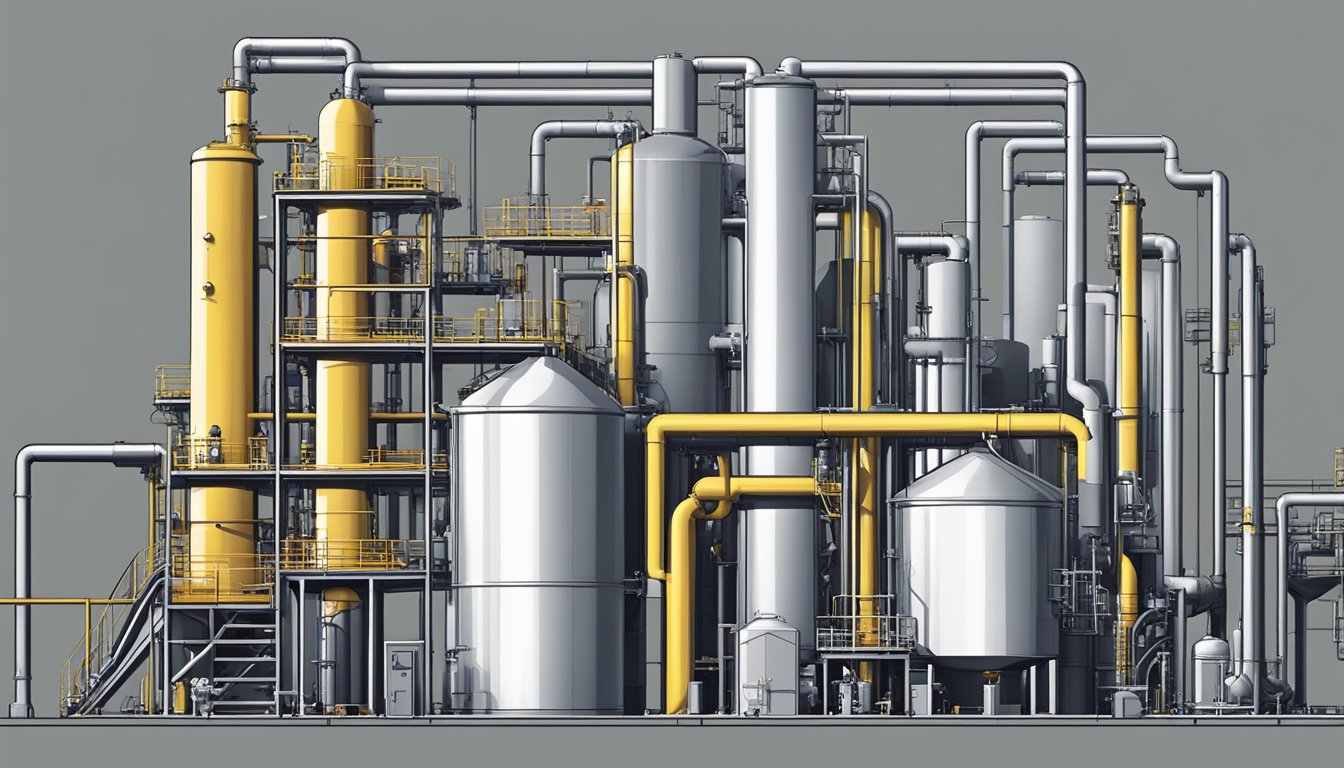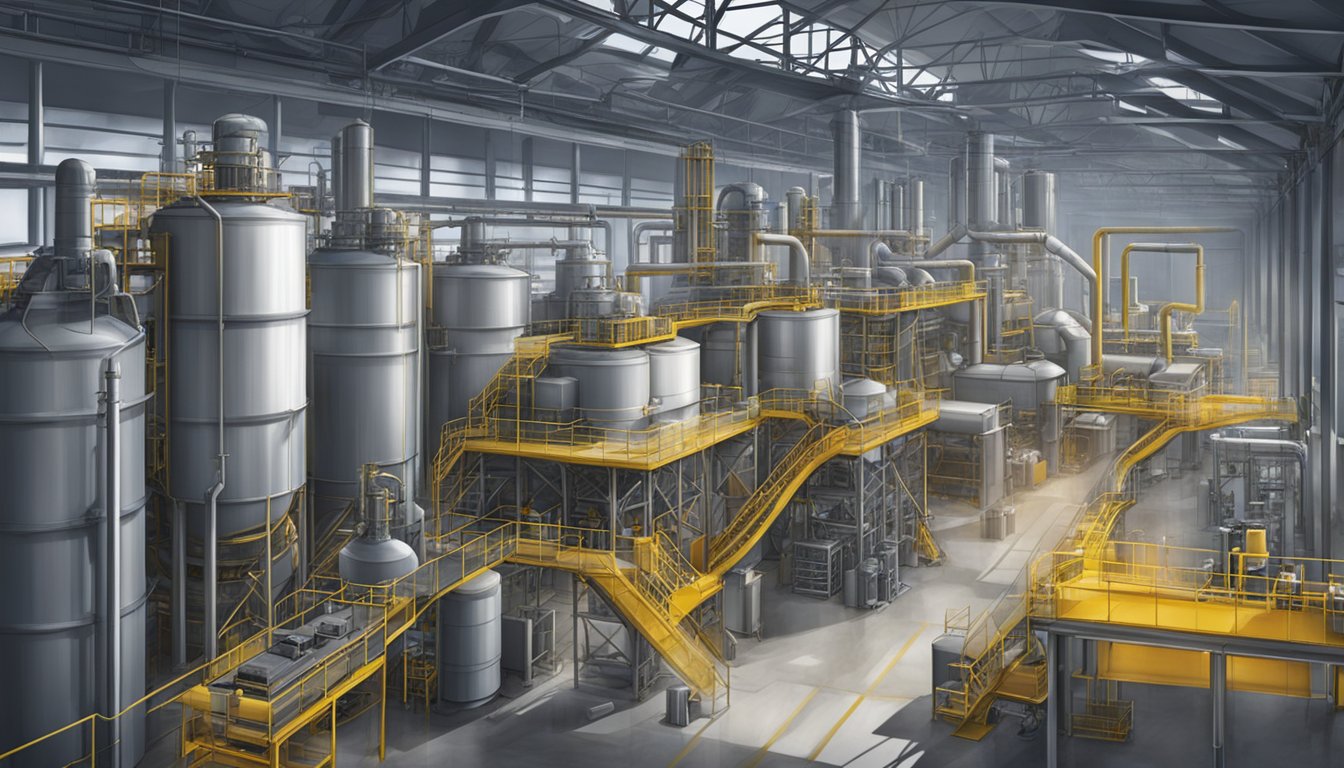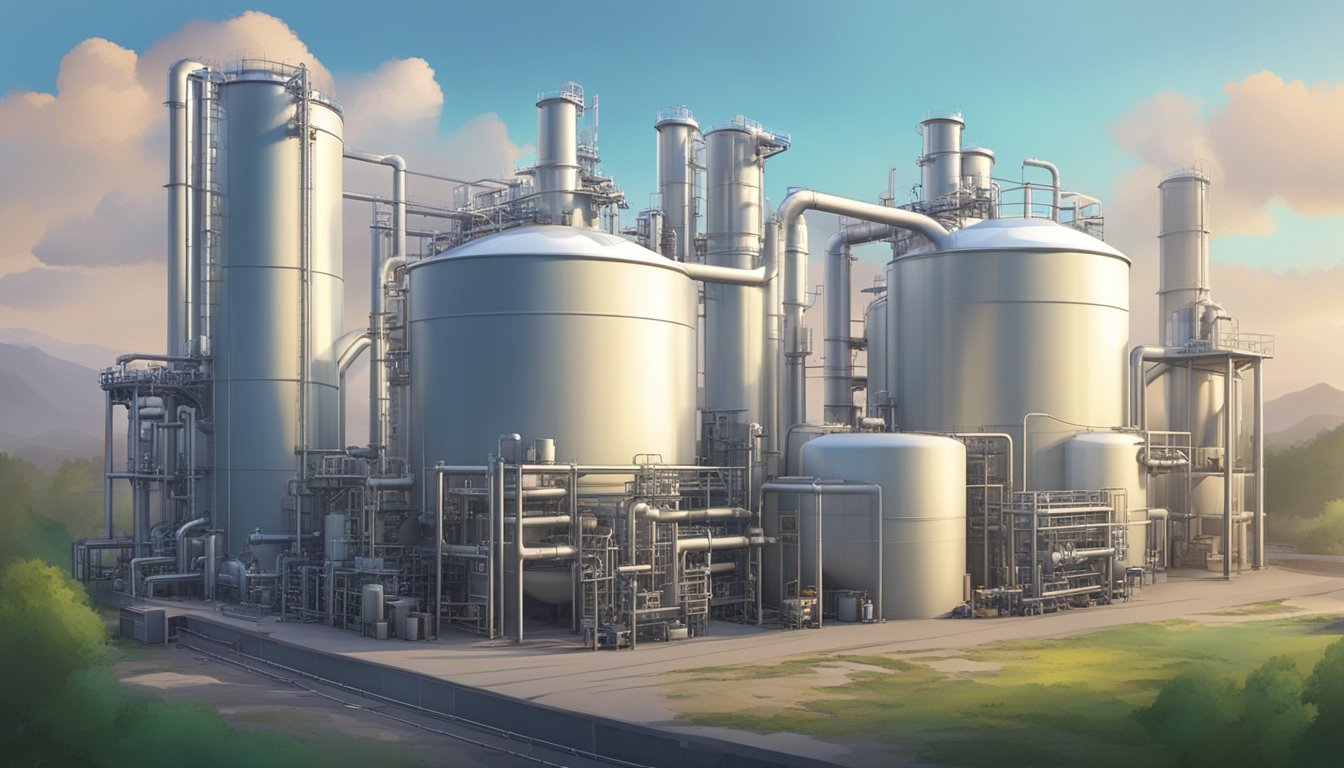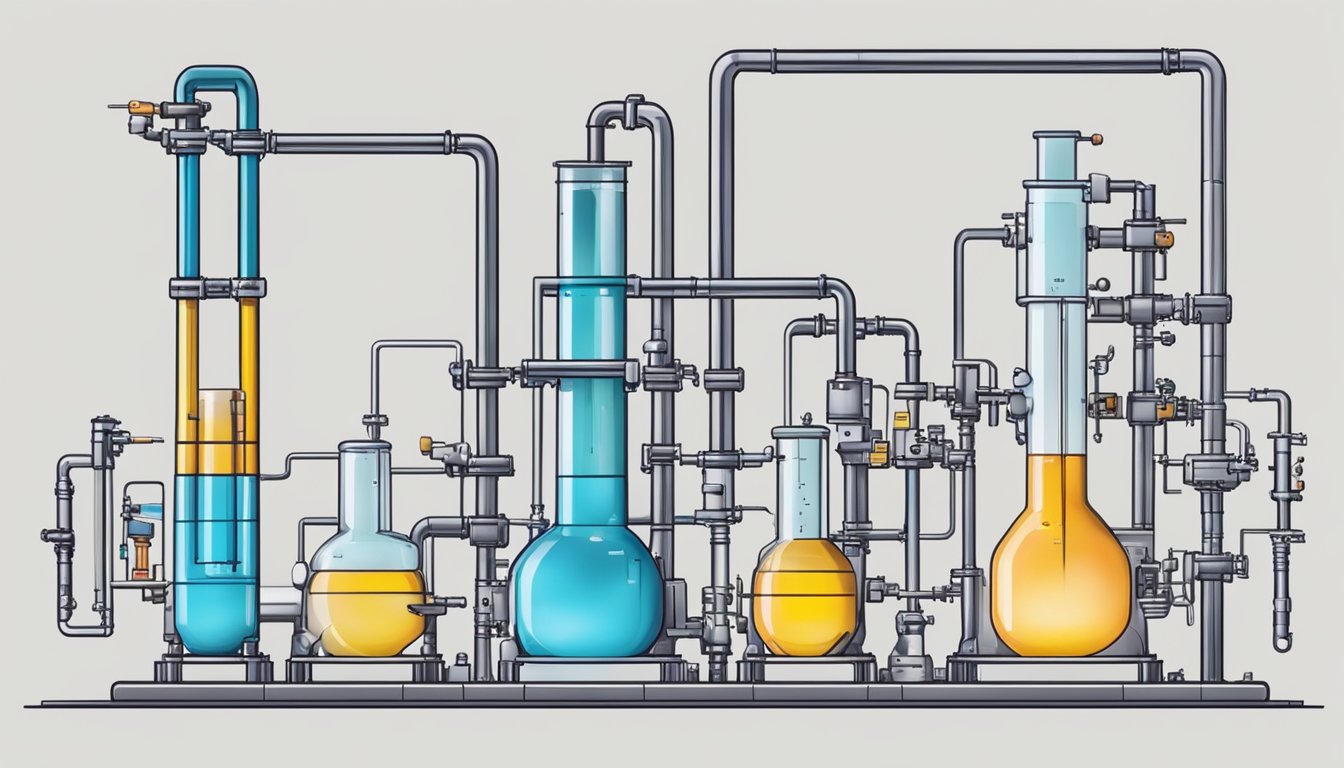Manufacture of Adipic Acid: Process and Applications
19/01/2024
Adipic acid is a white crystalline powder that is used in a wide range of applications, including the production of nylon, polyurethanes, and other polymers. It is one of the most widely used dicarboxylic acids in the world, with an annual production of over 2.5 billion kilograms. The manufacture of adipic acid is a complex process that involves several steps, including oxidation, nitration, and hydrogenation.

The primary raw materials used in the manufacture of adipic acid are cyclohexanone and cyclohexanol, which are typically obtained from petroleum-based sources. These materials are then oxidized using nitric acid to produce the corresponding ketone and alcohol intermediates. The ketone is then further oxidized to produce adipic acid, while the alcohol is hydrogenated to produce cyclohexanol, which can be recycled back into the process.
The manufacture of adipic acid is a critical process that requires careful attention to detail and strict quality control measures. The production of high-quality adipic acid is essential to ensure the performance and reliability of the end products in which it is used. With increasing demand for high-performance polymers and other materials, the manufacture of adipic acid is likely to remain a vital industry for many years to come.
Historical Context

Adipic acid is a dicarboxylic acid with the chemical formula (CH2)4(COOH)2. It is an important industrial chemical used primarily in the production of nylon. Its name is derived from the Latin word “adeps,” meaning fat, as it was originally obtained by oxidizing fats.
The first synthesis of adipic acid was reported in 1887 by German chemist Hermann Kolbe. He prepared it by oxidizing cyclohexanol with nitric acid. This method was later improved by German chemist Paul Sabatier, who used a platinum catalyst to reduce nitric oxide to nitrogen and water, thereby avoiding the production of toxic nitrogen oxides.
In the early 1900s, the demand for adipic acid increased due to the growing popularity of nylon. The first commercial production of adipic acid began in the United States in the 1930s. It was produced by oxidizing cyclohexane with nitric acid, a process that is still used today.
In the 1950s, a more efficient method of producing adipic acid was developed by British chemist Derek Barton. This method involved the use of a cobalt catalyst to oxidize cyclohexene with oxygen. This method is now the most widely used method for the production of adipic acid.
Today, adipic acid is produced on a large scale, with an annual global production of over 2.5 million tons. It is an important chemical used in the production of nylon, polyurethanes, and other products.
Chemical Properties of Adipic Acid

Adipic acid is an organic compound with the formula (CH2)4(COOH)2. It is a white crystalline powder with a slightly bitter taste. Adipic acid is the most important dicarboxylic acid from an industrial perspective, with an annual production of approximately 2.5 billion kilograms worldwide.
Adipic acid has a melting point of 153°C and a boiling point of 337°C. It is soluble in water, ethanol, and ether, but insoluble in benzene and toluene. Adipic acid is a moderately strong acid with a pKa of 4.44.
One of the most important properties of adipic acid is its ability to undergo esterification and amidation reactions. These reactions are used in the synthesis of various polymers, including nylon-6,6, which is produced by the reaction of adipic acid with 1,6-hexanediamine.
Adipic acid is also used as a food additive, where it is classified as a flavoring agent and acidity regulator. It is added to certain foods to provide a slightly sour taste, and to adjust the pH of the product.
Overall, adipic acid is a versatile chemical with a wide range of applications in various industries. Its unique chemical properties make it an important building block for the synthesis of various polymers and other organic compounds.
Raw Materials

Adipic acid is a dicarboxylic acid that is primarily used in the production of nylon-6,6 polyamide. It is a white crystalline powder that is soluble in water and organic solvents. The two main raw materials used in the industrial production of adipic acid are cyclohexane and nitric acid.
Cyclohexane is a colorless liquid that is obtained from crude oil. It is an important intermediate in the production of adipic acid and is used as a solvent in various chemical processes. Nitric acid, on the other hand, is a strong oxidizing agent that is used to convert cyclohexane into cyclohexanone and cyclohexanol. These two compounds are then oxidized to produce adipic acid.
In addition to cyclohexane and nitric acid, other raw materials such as phenol, butadiene, and cyclohexene can also be used to produce adipic acid. Phenol is used as a raw material in the production of phenol-formaldehyde resins and other chemicals, while butadiene and cyclohexene are used as monomers in the production of synthetic rubbers and plastics.
The choice of raw materials used in the production of adipic acid depends on various factors such as availability, cost, and environmental impact. Cyclohexane and nitric acid have been the most widely used raw materials in the industrial production of adipic acid due to their availability and low cost. However, alternative production routes based on renewable feedstocks such as biomass and bio-based chemicals are being researched to reduce the environmental impact of adipic acid production.
Overall, the choice of raw materials used in the production of adipic acid is an important factor that affects the cost, quality, and environmental impact of the final product.
Preparation Methods

Adipic acid is a key organic diacid intermediate used in the manufacture of nylon, polyurethanes, and other industrial chemicals. There are several preparation methods for adipic acid, including cyclohexane oxidation, phenol hydrogenation, and bio-based production.
Cyclohexane Oxidation
The most common method for the production of adipic acid is the oxidation of cyclohexane. The process involves the oxidation of a mixture of cyclohexanone and cyclohexanol, called KA oil, using nitric acid as the oxidant. The pathway is multistep, and early in the reaction, the cyclohexanol is converted to the ketone, releasing nitrous acid. The process has a serious pollution impact on the environment due to the formation of waste nitrous oxide.
Phenol Hydrogenation
Phenol hydrogenation is another method for the production of adipic acid. The process involves the hydrogenation of phenol to cyclohexanone, which is then oxidized to adipic acid. The process has a lower environmental impact than cyclohexane oxidation as it does not produce nitrous oxide.
Bio-based Production
Bio-based production is an emerging method for the production of adipic acid. The process involves the use of biomass-derived glucose as a feedstock. There are three production pathways from biomass derivatives to adipic acid: chemical catalytic processes, indirect fermentation with chemical conversion, and direct fermentation. The direct fermentation pathway is the most promising method for bio-based production of adipic acid. It involves the use of microorganisms to convert glucose to adipic acid. The process has the potential to reduce the environmental impact of adipic acid production by using renewable resources and reducing waste.
The production of adipic acid is a complex process that involves several preparation methods. The choice of method depends on several factors, including cost, environmental impact, and availability of resources.
Catalysts Used in Synthesis
Adipic acid is commonly synthesized using either homogeneous or heterogeneous catalysts. The choice of catalyst depends on the reaction conditions, desired yield, and the type of feedstock used.
Homogeneous Catalysts
Homogeneous catalysts are usually metal ions or complexes that are soluble in the reaction medium. Common homogeneous catalysts used for adipic acid synthesis include cobalt, manganese, and vanadium. These catalysts are effective in promoting the oxidation of cyclohexene to adipic acid in the presence of hydrogen peroxide or nitric acid. However, homogeneous catalysts suffer from several drawbacks, such as the high cost of the catalyst, difficulty in separation from the reaction mixture, and environmental concerns related to the use of toxic solvents.
Heterogeneous Catalysts
Heterogeneous catalysts are usually solid materials that are insoluble in the reaction medium. They offer several advantages over homogeneous catalysts, such as easier separation from the reaction mixture, lower cost, and reduced environmental impact. Heterogeneous catalysts can be classified into several categories, including metal oxides, zeolites, and supported metal catalysts.
Metal oxide catalysts, such as titanium dioxide and tungsten oxide, are commonly used for the synthesis of adipic acid from cyclohexene. These catalysts are effective in promoting the selective oxidation of cyclohexene to adipic acid, but suffer from low selectivity and activity.
Zeolite catalysts are microporous materials that have high surface area and acidic properties. They are effective in promoting the isomerization of cyclohexene to the more reactive cis-cyclohexeneoxide, which can be further oxidized to adipic acid. However, zeolite catalysts suffer from low stability and selectivity.
Supported metal catalysts, such as platinum and palladium, are commonly used for the synthesis of adipic acid from biomass-derived feedstocks. These catalysts are effective in promoting the selective oxidation of glucose to glucaric acid, which can be further converted to adipic acid. Supported metal catalysts offer several advantages over other heterogeneous catalysts, including high selectivity, activity, and stability.
Process Optimization
The production of adipic acid involves a series of steps that can be optimized to increase efficiency and reduce costs. One of the key steps in the production process is the oxidation of cyclohexane to produce cyclohexanone and cyclohexanol, which are then oxidized to produce adipic acid.
To optimize this step, various catalysts and reaction conditions can be used. For example, a catalyst such as cobalt acetate can be used to increase the yield of adipic acid. Additionally, increasing the temperature and pressure of the reaction can also increase the yield of adipic acid.
Another important factor in the production of adipic acid is the purification process. This involves the removal of impurities such as water, unreacted cyclohexane, and other byproducts. One method of purification is through crystallization, where the adipic acid is dissolved in a solvent and then cooled to form crystals.
Furthermore, the use of renewable feedstocks such as lignocellulosic biomass can also be explored to optimize the production process. This can reduce the reliance on fossil fuels and decrease the environmental impact of the production process.
Overall, optimizing the production process of adipic acid can lead to increased efficiency, reduced costs, and a more sustainable manufacturing process.
Purification Techniques
Adipic acid is typically produced as a crude mixture, and must be purified before it can be used in downstream applications. The most commonly used purification techniques are crystallization, distillation, and extraction.
Crystallization
Crystallization is a widely used technique for purifying adipic acid. In this process, the crude mixture is dissolved in a solvent such as water, and then cooled to induce crystallization. The resulting crystals are then separated from the solvent by filtration or centrifugation. The purity of the resulting adipic acid crystals depends on the cooling rate, solvent choice, and other process parameters.
Distillation
Distillation is another common technique for purifying adipic acid. In this process, the crude mixture is heated to vaporize the adipic acid, which is then condensed and collected as a liquid. This process is typically carried out under vacuum to minimize thermal degradation of the adipic acid. Distillation is particularly useful for removing impurities such as water and other low-boiling components.
Extraction
Extraction is a less commonly used technique for purifying adipic acid, but can be useful in certain circumstances. In this process, the crude mixture is dissolved in a solvent that selectively extracts the adipic acid. The resulting solution is then separated from the solvent by evaporation or distillation. Extraction is particularly useful for removing impurities that are not easily removed by crystallization or distillation.
Overall, each of these techniques has its own advantages and disadvantages, and the choice of technique will depend on the specific requirements of the downstream application.
Waste Management and Environmental Impact
Adipic acid production is known to have a significant environmental impact, particularly in terms of waste management. The traditional process of adipic acid production involves the use of nitric acid and cyclohexane, which can generate significant amounts of waste products. These waste products include nitrous oxide (N2O), which is a potent greenhouse gas that contributes to climate change.
To mitigate the environmental impact of adipic acid production, many manufacturers have implemented waste management strategies. One such strategy is the use of catalytic oxidation to convert N2O into harmless nitrogen and oxygen gases. This process has been shown to significantly reduce the emissions of N2O from adipic acid production facilities.
Another strategy is the use of renewable feedstocks, such as biomass, to produce adipic acid. This approach can significantly reduce the environmental impact of adipic acid production by reducing the use of fossil fuels and minimizing waste products. Some manufacturers are also exploring the use of microbial upcycling of waste PET to produce adipic acid, which has the potential to further reduce the environmental impact of adipic acid production.
In addition to waste management strategies, manufacturers of adipic acid are also exploring ways to improve the energy efficiency of the production process. This includes the use of process optimization and energy recovery technologies, such as heat exchangers and cogeneration systems. By improving energy efficiency, manufacturers can reduce their reliance on fossil fuels and minimize their carbon footprint.
Overall, the adipic acid industry is taking steps to reduce its environmental impact through the implementation of waste management strategies and the adoption of renewable feedstocks. As a consumer, you can also help reduce the environmental impact of adipic acid production by choosing products made from sustainable materials and supporting manufacturers that prioritize environmental sustainability.
Safety and Handling
When handling adipic acid, it is important to take necessary precautions to ensure your safety and the safety of those around you. Adipic acid is a white crystalline solid that can irritate the skin and eyes upon contact. Therefore, it is important to wear protective gloves, goggles, and clothing when handling this substance.
In addition to protective gear, it is also important to handle adipic acid in a well-ventilated area to avoid inhaling the dust. Explosion-proof exhaust ventilation or other engineering controls should be used to keep adipic acid dust concentrations below any recommended or statutory limits [1].
If you accidentally come into contact with adipic acid, it is important to immediately wash the affected area with soap and water. If the substance is inhaled, seek fresh air and medical attention immediately. Adipic acid is classified as a corrosive substance and can cause serious eye damage [2].
In conclusion, handling adipic acid requires proper protective gear, well-ventilated areas, and caution to avoid contact with skin, eyes, and inhalation. By following these safety guidelines, you can ensure a safe and efficient manufacturing process.
Applications of Adipic Acid
Adipic acid is a versatile chemical compound that finds application in a wide range of industries. Some of the most common applications of adipic acid include:
Nylon Production
Adipic acid is a key raw material used in the manufacture of nylon. Nylon is a synthetic polymer that is widely used in the textile industry to make fabrics, carpets, and other materials. Adipic acid is used in the production of nylon-6,6, which is a type of nylon that is widely used due to its excellent mechanical properties, high melting point, and good chemical resistance.
Plasticizers
Adipic acid is also used as a plasticizer in the production of plastics, especially PVC. Plasticizers are chemicals that are added to plastics to make them more flexible and easier to process. Adipic acid esters are commonly used as plasticizers due to their low toxicity, good compatibility with PVC, and high boiling point.
Polyurethanes
Adipic acid is also used in the production of polyurethanes, which are widely used in the construction, automotive, and furniture industries. Polyurethanes are a type of polymer that can be made into foams, adhesives, coatings, and other materials. Adipic acid is used in the production of polyurethane foams, which are used in the manufacture of mattresses, cushions, and insulation materials.
In addition to these applications, adipic acid is also used as an acidulant for gelatins and jams, as a food additive for buffering or neutralizing, to make insect repellent, as a starch crosslinking agent, and as an intermediate for paints.
Market Trends and Economics
Adipic acid is a vital chemical used in the production of nylon 6,6, polyurethanes, and other products. It is a highly demanded chemical due to its versatile applications in various industries, including automotive, textile, and electronics. The adipic acid market is projected to grow steadily in the coming years. According to Mordor Intelligence, the market is expected to register a CAGR of more than 3% during the forecast period.
The Asia-Pacific region is expected to dominate the adipic acid market due to the rising demand for adipic acid in major countries such as India and China. These countries have a massive demand for adipic acid in the automotive, textiles, and electronics industries. China is the world’s largest producer of electronics, which contributes significantly to the market’s growth.
The global adipic acid market size was valued at around USD 5.65 billion in 2021 and is expected to reach around USD 8.18 billion by 2030, expanding at a CAGR of 4.92% during the forecast period, 2022-2030. The growth of the market is attributed to the rising demand for lightweight vehicles in the automotive industry. Adipic acid is used to manufacture lightweight materials that improve fuel efficiency and reduce carbon emissions.
The current commercial petrochemical process that produces adipic acid from KA oil and is catalyzed by nitric acid seriously pollutes the environment. Therefore, there is a growing trend towards the development of eco-friendly processes to manufacture adipic acid. Companies are investing in research and development to develop sustainable and environmentally friendly processes to produce adipic acid. This trend is expected to continue in the coming years as the demand for eco-friendly products increases.
In conclusion, the adipic acid market is expected to grow steadily in the coming years due to its versatile applications in various industries. The Asia-Pacific region is expected to dominate the market due to the rising demand for adipic acid in major countries such as India and China. The trend towards the development of eco-friendly processes to manufacture adipic acid is expected to continue in the coming years.
Future Prospects and Innovations
As the demand for adipic acid continues to grow, manufacturers are exploring innovative and sustainable ways to produce this versatile chemical. One promising area of research is the use of renewable feedstocks such as biomass derivatives to synthesize adipic acid. According to a study published in Chemistry – A European Journal, sustainable routes for the synthesis of renewable adipic acid from biomass derivatives have been developed and show great potential for future production.
Another area of innovation is the development of new catalysts and processes to reduce the environmental impact of adipic acid production. The current commercial petrochemical process that produces adipic acid from KA oil and is catalyzed by nitric acid seriously pollutes the environment by producing waste nitrous oxide. Researchers are exploring alternative catalysts and processes that are more environmentally friendly and efficient.
In addition to sustainable production methods, there is also a growing interest in the development of new applications for adipic acid. One potential application is in the production of biodegradable plastics, which are becoming increasingly important in the fight against plastic pollution. Adipic acid can be used to produce biodegradable polyesters such as polybutylene adipate terephthalate (PBAT), which have similar properties to traditional plastics but are biodegradable.
Overall, the future of adipic acid looks promising as manufacturers continue to explore innovative and sustainable production methods and new applications for this versatile chemical.
Frequently Asked Questions
What are the primary methods for producing adipic acid industrially?
Adipic acid is primarily produced by two industrial methods: the cyclohexane process and the phenol process. In the cyclohexane process, cyclohexane is oxidized with nitric acid to produce a mixture of cyclohexanone and cyclohexanol, which are then oxidized with nitric acid to produce adipic acid. In the phenol process, phenol is oxidized with nitric acid to produce a mixture of cyclohexanone and cyclohexanol, which are then oxidized with nitric acid to produce adipic acid.
Which raw materials are essential in the synthesis of adipic acid?
The raw materials essential for the synthesis of adipic acid are cyclohexane or phenol, nitric acid, and air.
What are the main applications of adipic acid in various industries?
Adipic acid is primarily used in the production of nylon 6,6, which is used in a variety of applications, including fibers, textiles, and engineering plastics. It is also used in the production of polyurethanes, lubricants, plasticizers, wet strength resins, coatings, adhesives, sealants, and elastomers. Adipic acid is also used in the production of pharmaceutical products, perfumes, and cosmetics.
Can you describe the solubility characteristics of adipic acid in water?
Adipic acid is slightly soluble in water, with a solubility of approximately 1.4 g/100 mL at room temperature.
What safety precautions should be taken when handling adipic acid?
Adipic acid is a corrosive and toxic substance that can cause severe skin, eye, and respiratory irritation upon contact. It is important to wear protective clothing, gloves, and goggles when handling adipic acid. Adipic acid should be stored in a cool, dry, and well-ventilated area away from heat, sparks, and flames.
At what temperature does adipic acid reach its boiling point?
Adipic acid has a boiling point of approximately 337°C (639°F) at standard pressure.




